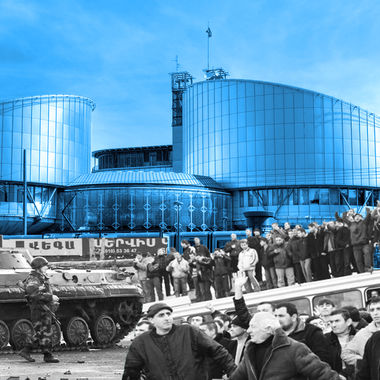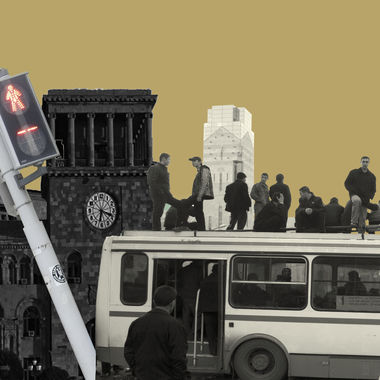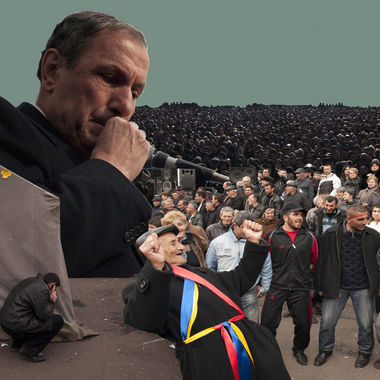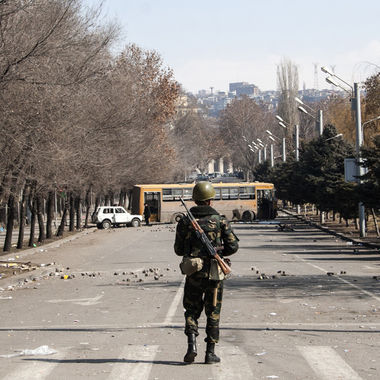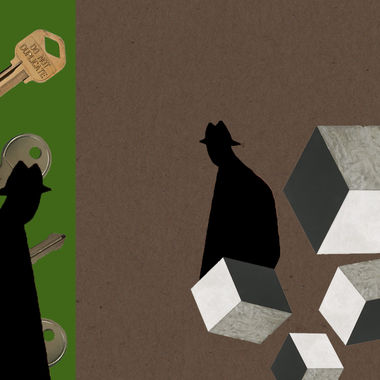Thu Sep 12 2019 · 10 min read
On the Use of the Army in Suppressing Protests in Armenia in March 2008

By Sossi Tatikyan
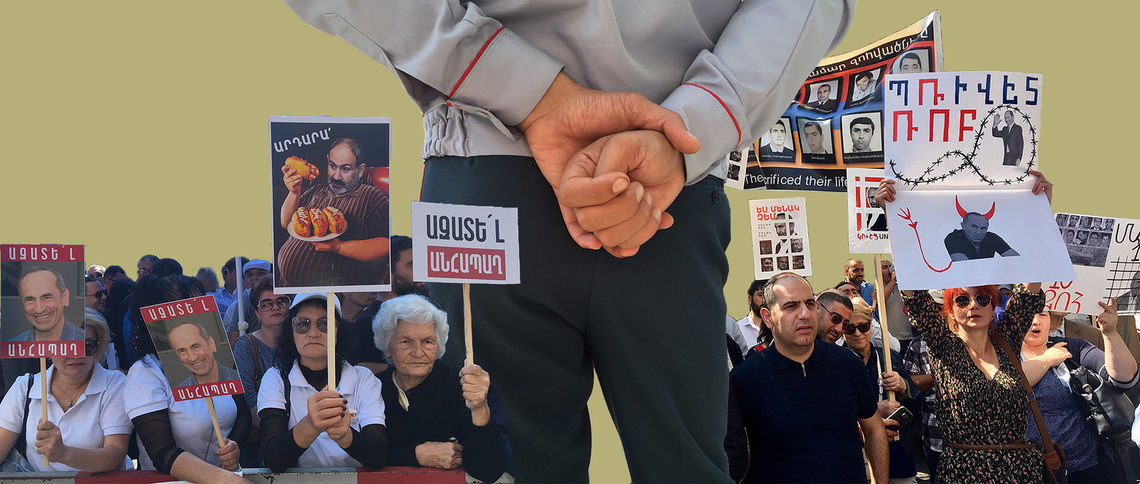
Images used in this graphic are from the September 12, 2019, rally outside of the Court House during the hearing of the March 1 case.
In March 2008, nonstop opposition demonstrations against the outcome of disputed presidential elections were eventually suppressed by force by outgoing President Robert Kocharyan to ensure his preferred successor Serzh Sargsyan. The use of force against demonstrators resulted in the killing of eight protesters and two police, who died of different causes, including gunshot wounds, injuries from fragments of tear gas canisters and blunt objects. This was accompanied by the declaration of a 20-day state of emergency by Kocharyan. It is not confirmed whether Kocharyan declared the state of emergency in consultation with the Government or the National Assembly or not - there are different reports on this matter and no document proving that it was a consultative decision. The Armenian parliament, however, did vote to confirm the state of emergency afterwards (81 of the 131 parliamentarians voted in favor of the measure). Part of the allegations against Kocharyan is that not only the police but also the army was used in the crackdown on the protesters by the authorities upon signing secret order N. 0038 by then Defense Minister Mikael Harutyunyan on February 23, 2008, before the declaration of a state of emergency. The secret order described the protesters as “those who haven’t accepted the results of the presidential election and are destabilizing the country.”
Under pressure from the Parliamentary Assembly of the Council of Europe (PACE), in October 2008, Armenian authorities established an independent inquiry into the March 1 events. However, the activities of the fact-finding group ceased in June 2009 after the release of the group’s first report. According to Andranik Kocharyan [no relation to Robert Kocharyan], the Head of the Fact-Finding Group, “the authorities realized how dangerous the findings of the Group may prove for them, and therefore dissolved it…proven are the details of the violence and participation of the army and the actions of the groups of gangs formulated by oligarch officials and the police forces.” According to Andranik Kocharyan, a “secret military headquarters was set up to allow the Armed Forces to monitor the situation during the state of emergency.”
Following the Velvet Revolution of April-May 2018, one of the leaders of 2008 protests – Nikol Pashinyan became the Prime Minister of Armenia, and the investigation of March 2008 was re-opened. Second President Kocharyan was arrested three times between July 2018 and June 2019 and is currently being held in pre-trial detention accused of overthrowing the constitutional order in 2008. Kocharyan is accused of ordering some units of the Armenian armed forces to use force against opposition supporters.
Kocharyan’s testimonies in relation to the use of the army in suppressing the protests were inconsistent and changed throughout the trial - first, it was a denial of the involvement of the army; secondly, he claimed of not being aware of the secret order by the Defense Minister; third was an admission of the involvement of the army but insisting that the army units did not use weapons and did not participate in clashes with opposition followers, surveilling the situation from afar; fourthly, accusing the leaders of the protests in not accepting election results, provoking mass disorder, and claiming protesters of being armed with weapons and hand grenades, and even an attempt by “outside agitators” to involve certain units of the army in supporting the protests; and finally, statements by him and his attorneys that it is a normal practice all over the world to use the army to tackle internal security threats. At the same time, Kocharyan described the ongoing trial as a political “vendetta” against him by the current government. His attorney also argued that Ter-Petrosian, Armenia’s first president, deployed troops in the center of Yerevan in the wake of another disputed presidential election held in September 1996, when he declared a state of emergency after opposition protests against his alleged fraudulent reelection turned violent.
Apart from Kocharyan, the Special Investigative Service announced that an arrest warrant had been issued for former Defense Minister Mikayel Harutyunyan, former Chief of Defense Staff Seyran Ohanyan and former Deputy Defense Minister Yuri Khachaturov as part of its investigation of the March 1 events, on charges of participation in overthrowing constitutional order in 2008 with the involvement of the armed forces. Khachaturov was relieved from his duties of the Head of the Collective Security Treaty (CSTO) in 2018.
According to the BBC report published by its Russian Service in August 2019, Major General of the armed forces of Artsakh Samvel Karapetyan also called Samvel Oganovski, led the operation with a group of 20 officers and sub-officers, including snipers, who were removed from their military positions responsible for external defense and deployed to Yerevan. According to the testimony of several prominent military commanders, such as Movses Hakobyan, the former Minister of Defense of Artsakh and Major General Samvel Karapetyan, have admitted the deployment of the army in their testimonies, at the same time justifying it by the secret order signed by President Kocharyan. Taking advantage of the domestic situation in Armenia, Azerbaijani forces in March 2008, launched military operations, briefly seizing several Armenian positions in Artsakh (Nagorno Karabakh), which were later regained by the Armenian side in a counteroffensive.
The Constitution of Armenia of 2005 defined that the armed forces shall ensure the security, defense and territorial integrity of Armenia, as well as the inviolability of its borders. It also stated that the armed forces shall maintain neutrality in political matters and shall be under civilian control. It didn’t have provisions on the functions of the Police and National Security Service, which is unusual in international practice and results in the lack of delineation of responsibilities and functions between different security forces and services. The Constitution also established that in case of an imminent threat to the constitutional order, the President of Armenia, by consulting with the Chairperson of the National Assembly and the Prime Minister, had the authority to declare a state of emergency, implement measures dictated by the situation and address the people with a message on the subject. In case of a declaration of a state of emergency, a special sitting of the National Assembly was to be convened without delay by virtue of law. The legal regime of a state of emergency had to be defined by law.
The Law on the Legal Regime on the State of Emergency adopted in 2012 defines that whenever it is not possible to accomplish the objectives of the state of emergency solely by the use of the police and national security forces, armed forces may be involved within the framework of cooperation, and in mutual support to fulfill such tasks as the protection of essential sites and ceasing the activities of illegal armed units.
In 2015, Armenia adopted a new Constitution signifying its transition from a presidential to a parliamentary system of governance. The new Constitution largely repeats the provisions of the old Constitution in relation to the political neutrality and mandate of the armed forces without any reference to the functions of the Police and National Security Service. It also establishes that in the event of an imminent danger posed to the constitutional order, the Government shall declare a state of emergency, take measures resulting from the situation and address the people. However, it adds that the decision on the use of the armed forces may be taken by the Government. In case of urgent necessity, the Prime Minister shall, upon recommendation of the Minister of Defence, take a decision on the use of the armed forces and shall immediately inform the members of the Government thereon, without specifying the situation when the armed forces can be used – war, state of emergency, etc, which is also highly unusual in constitutional law. The new Constitution requires a special sitting of the National Assembly to be convened by virtue of law, in case of a declaration of a state of emergency. However, it doesn’t require the National Assembly to approve the state of emergency before starting its application, instead giving it a right to lift the state of emergency or cancel the implementation of measures provided for under the legal regime of a state of emergency, by a majority of votes of the total number of Deputies. It establishes once again that the legal regime of a state of emergency shall be prescribed by a law adopted by a majority of votes of the total number of Deputies. The Law on the Legal Regime on the State of Emergency was amended accordingly in 2017.
It is worth noting that while the “Velvet Revolution” was evolving in Armenia in April-May 2018, many feared a repetition of the March 2008 scenario. However, Prime Minister Serzh Sargsyan chose not to use the army to suppress the non-violent revolution, instead he resigned paving the way for opposition leader Pashinyan to be elected as a PM. “The situation has several solutions, but I will not take any of them. They are not mine,” Serzh Sargsyan concluded in his resignation statement. It can be explained by the lack of willingness of Sargsyan to have another bloodshed similar to the one that had brought him to power, perhaps also strengthened by the realization of his lack of popular support.
The OSCE Code of Conduct on Politico-Military Aspects of Security adopted in 1994 underlines the requirement for the political neutrality of armed forces and for the prohibition of a domestic use of force aimed at restricting the peaceful and lawful exercise of human and civil rights. It also sets up conditions regulating the domestic use of force, such as constitutionality, respect for the rule of law during the performance of the operations, the use of armed forces to be commensurate with the needs for enforcement; and the need to avoid injury to civilians or their property. The Handbook on Human Rights and Fundamental Freedoms of Armed Forces Personnel of OSCE/ODIHR establishes “The Responsibility of Commanders and Individual Accountability” for the improper or illegal orders that violate national law and therefore constitute a crime.
Countries that use the army to restore public order and security tend to justify it by their ill-equipped, ill-trained and small police, the presence of non-state armed groups, the threat of terrorism, none of which is applicable for Armenia, and finally, by the threat to the constitutional order and resorting to violence by the protesters; this was a justification used by Kocharyan. However, even in that case, the declaration of a state of emergency was necessary for the use of army, which was enacted only retrospectively. The army could be used only to support the police in case of extreme violence by the protesters - which did not seem to be the case during protests in February-March 2008 - but not to use lethal weapons and cause casualties. Although the relevant provisions of the 2015 Constitution give more opportunity for the use of army, than the previous one, nevertheless, eventually the political will of the Head of State at the time determined its use or non-use. And finally, armies or various units of the army in different countries have reacted to the instruction to suppress protests differently, largely determining the outcome of various uprisings, revolutions and protests, such as during the Arab Spring.
At the same time, there is a need to amend the relevant provisions of the Constitution to delineate the distinct responsibilities of the army and internal security forces, and to ensure checks and balances for declaring a state of emergency, including a discussion in the Security Council and parliamentary approval. to avoid the instrumentalization of the army for the political purposes of the ruling elite.
The army and the police have different functions and they receive different training. The involvement of the army in restoring and maintaining public order and security may be required in case of terror attacks, armed uprisings or violent riots. However, it is necessary to establish modalities for the use of army to restore public security and order, such as declaration of a state of siege or emergency, preferably decided not solely by the Head of State but recommended by the Government or the National Security Council and approved by the Parliament. Even after ensuring that procedure, the army must not be in charge of the situation but under civilian oversight, stay in the second line and in support of the police, and its active intervention must be only in extreme cases, i.e. the police, citizens or public sites are subjected to an armed attack or extreme violence, and the police are not able to resist. Even in the case of its active intervention, the use of force by the army as well as the police should be proportional to the violence used by the rebels or protesters and avoid the excessive use of force, and especially the use of lethal weapons causing casualties by all means.
As a general principle, both the army and the police should be politically neutral. They should not be instrumentalized neither for maintaining the power of the governing elite nor for its replacement with another by the opposition.
Apart from the allegations of the killings of people and being used to overthrow constitutional order, the involvement of the army in this case generates additional key issues: First, the deployment of the military from their positions in Artsakh to the capital could escalate the conventional defense threat. Secondly, it is not clear whether the military can be exempt from liability for shooting at the people, justifying it by the secret order received from the Head of State or at least the military commanders should be held accountable. This case also shows that the political will of the Head of State largely determines the use or non-use of the army in suppressing protests. Finally, it warns that even if the ruling elite of the country keeps their power through the use of the army against protesters in the short run, their credibility and popularity severely suffer as a result, and it is likely that they will be held accountable by the succeeding authorities, especially if excessive force has been applied, and protesters have been killed.
also read
Vahe Grigoryan on the Events of March 1, a Dysfunctional Judiciary and Transitional Justice
By Maria Titizian
Is it possible to restore and rehabilitate Armenia’s judiciary? Vahe Grigoryan talks about the significance of a landmark judgment by the ECHR relating to the events of March 1, 2008 when security forces cracked down on peaceful protesters during post-election demonstrations leaving ten people dead.
Autocratic Arrogance: Kocharyan’s Arrest, His Apologists and Accountability
By Nerses Kopalyan
Nerses Kopalyan examines and debunks the arguments that the arrest and detention of Armenia’s second President Robert Kocharyan is politically motivated and that the basis of the arrest lacks cogent and substantive legal foundations. Kocharyan has been charged with “overthrowing constitutional order” regarding the events of March 1, 2008 that left ten people dead.
Ten Victims, Ten Years, Zero Culpability
By Hamazasp Danielyan
Ten years after the worst post-election clashes in the history of Armenia’s independent statehood that left ten people dead and hundreds injured, the wounds are still fresh and the pain raw. In this personal essay, Hamazasp Danielyan writes about the events leading up to March 1, 2008 and reflects on his personal transformation.
2008: Post-Election Armenia in Images
By 4 Plus
On March 1, 2008, police units move in to put an end to ongoing protests disputing the results of the February 19, Presidential Elections in Armenia. In the aftermath ten people are dead, hundreds were injured. The reality before and after March 1st as seen through the lenses of the members of the 4Plus photo collective.
by the same author
On the Elaboration of Armenia’s New National Security Strategy
By Sossi Tatikyan
Armenia is set to have a new National Security Strategy. The current strategy, adopted in January 2007, had all the necessary components, but was outdated and remained a largely superficial and declarative document as many of the defined values and principles were not fully respected or promoted.

